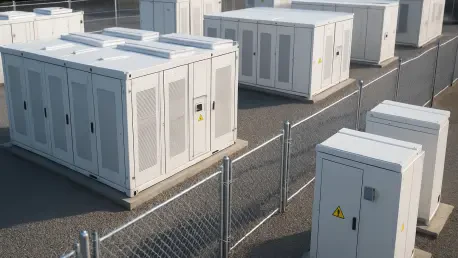In an era where artificial intelligence and advanced computing are pushing data centers to their limits, the struggle to secure reliable and immediate access to grid power has become a defining issue for the industry, with demand skyrocketing and traditional utility upgrades often lagging behind, delaying critical projects by years and stalling technological progress. Amid this challenge, a groundbreaking collaboration between two innovative companies in the Pacific Northwest is showcasing how battery energy storage systems (BESS) can offer a transformative solution. By deploying cutting-edge technology at a major data center campus under construction in Hillsboro, Oregon, this project is not only addressing immediate power constraints but also setting a new standard for grid reliability and operational efficiency. This development signals a shift in how the sector can navigate power limitations, promising faster project timelines and enhanced sustainability in a landscape increasingly shaped by AI-driven growth.
Addressing Grid Power Constraints with Innovation
Pioneering Battery Storage in Hillsboro
The deployment of a 31 MW and 62 MWh battery energy storage system at a data center campus in Hillsboro, Oregon, represents a significant leap forward in tackling grid power access issues. This system, designed to store surplus energy during periods of high production and release it during peak demand, effectively smooths out power fluctuations that often plague data centers. By acting as a grid-responsive asset, it ensures a stable energy supply while supporting regional grid stability. What sets this project apart is its ability to bring the facility online years earlier than would have been possible through conventional utility upgrades. The collaboration with a regional utility from the project’s outset highlights a cooperative model that accelerates interconnection approvals, allowing the campus to meet the urgent needs of tech-driven markets without the typical delays associated with infrastructure enhancements.
Redefining Operational Timelines
Beyond stabilizing power supply, the Hillsboro initiative showcases how battery storage can redefine operational timelines for data centers in power-constrained regions. Positioned in Oregon’s “Silicon Forest,” a hub for tech giants, this 27-acre campus is set to exceed 100 MW in capacity upon completion, making it a critical asset in the area. The BESS, developed through a specialized solution known as Path to Power, marks the first purpose-built system in the U.S. aimed at speeding up large-scale data center interconnections. By transforming potential grid liabilities into dynamic assets, this technology provides utilities with tools to facilitate faster operational ramps. Industry leaders have noted that such innovations turn traditional challenges into opportunities, ensuring that data centers can scale rapidly to meet demand without being hindered by outdated grid infrastructure or lengthy approval processes.
Industry Trends and Strategic Implications
Rising Demand and the AI Boom
The urgency for innovative power solutions in the data center sector has never been more apparent, driven largely by the exponential growth of AI infrastructure. A recent $40 billion acquisition of a major data center operator by a consortium of high-profile tech and investment firms underscores the scale of this boom, reflecting a market likened to historical industrial expansions. Analysts describe this wave of investments and acquisitions as a clear indicator of the strategic importance of scalable, power-efficient facilities. Distributed energy solutions like BESS are increasingly seen as indispensable rather than optional, particularly in markets where grid capacity struggles to keep pace with technological advancements. This trend highlights a broader industry shift toward integrating advanced energy storage to manage the unprecedented power demands imposed by AI and other cutting-edge applications.
Long-Term Benefits for Grid Sustainability
Looking at the broader impact, the Hillsboro project illustrates how battery storage contributes to long-term grid reliability and sustainability. By supporting a low-carbon energy framework, the system not only addresses immediate power access challenges but also aligns with environmental goals critical to modern infrastructure projects. The partnership behind this initiative has set a precedent for future endeavors, with both companies confirming potential replication in other markets facing similar constraints. This approach offers a viable middle ground between waiting years for grid upgrades and opting for off-grid solutions, reshaping growth strategies in power-limited regions. The emphasis on turning grid loads into assets reflects a forward-thinking mindset that prioritizes both operational efficiency and ecological responsibility, paving the way for a more resilient data center ecosystem.
Charting the Path Forward
Reflecting on a Transformative Milestone
Looking back, the collaboration in Hillsboro stood as a pivotal moment in addressing one of the most pressing challenges in the data center industry—securing reliable grid power. The implementation of a robust battery storage system demonstrated a practical solution that bypassed traditional delays, enabling faster operational timelines and bolstering grid stability. This project not only met the immediate needs of a burgeoning tech hub but also highlighted the potential for distributed energy solutions to redefine industry standards. The massive financial backing through high-profile acquisitions further validated the critical role of such infrastructure in supporting AI-driven advancements, marking a significant chapter in the evolution of data center power management.
Envisioning Future Solutions
As the industry moves forward, the success of the Hillsboro initiative offers a blueprint for other regions grappling with similar power constraints. Stakeholders should consider investing in scalable battery storage technologies to mitigate grid limitations and accelerate project timelines. Exploring partnerships with utilities and energy innovators can further enhance interconnection processes, ensuring that data centers remain agile in meeting demand. Additionally, prioritizing sustainable energy frameworks will be key to balancing growth with environmental stewardship. The path ahead lies in leveraging these lessons to build a more resilient infrastructure, capable of supporting the relentless pace of technological progress while addressing the intricacies of power availability in an increasingly digital world.









